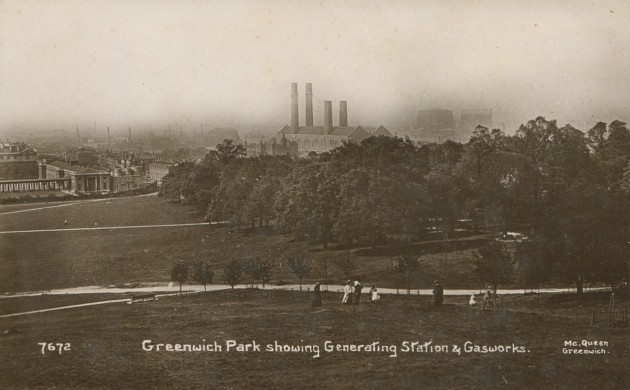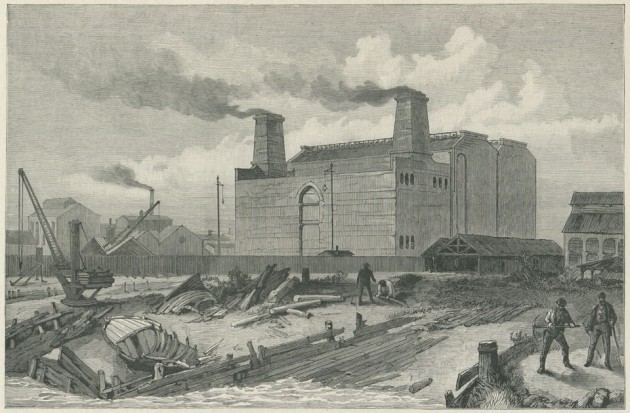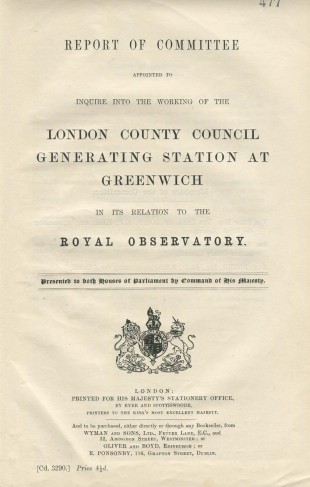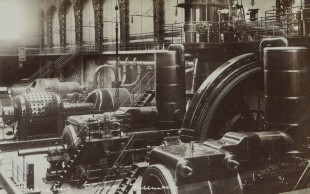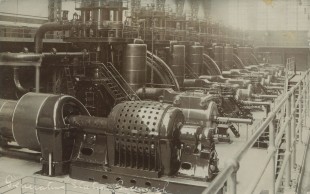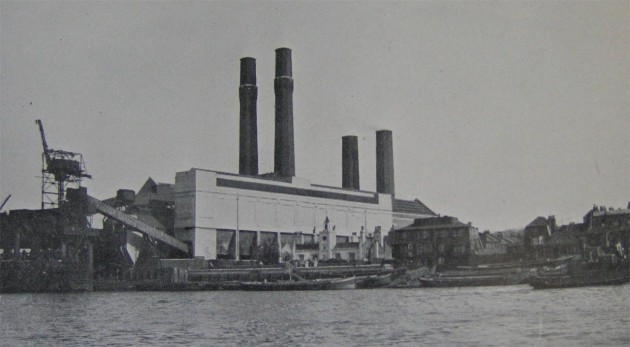…where east meets west
- Home
- Brief History
- The Greenwich Meridian
- Greenwich
(1675–1958) - Herstmonceux
(1948–1990) - Cambridge
(1990–1998) - Outstations (1822–1971)…
- – Chingford (1822–1924)
- – Deal
(1864–1927) - – Abinger
(1923–1957) - – Bristol & Bradford on Avon
(1939–1948) - – Bath
(1939–1949) - – Hartland
(1955–1967) - – Cape of Good Hope
(1959–1971)
- Administration…
- – Funding
- – Governance
- – Inventories
- – Pay
- – Regulations
- – Royal Warrants
- Contemporary Accounts
- People
- Publications
- Science
- Technology
- Telescopes
- Chronometers
- Clocks & Time
- Board of Longitude
- Libraries & Archives
- Visit
- Search
Greenwich Power Station
In 1902, work was started by the London County Council (L.C.C) on the construction of a Power Station (Generating Station) at Greenwich for the supply of electricity to their tramways. Built on the banks of the River Thames at a distance of just half a mile from the Observatory and exactly on the line of the Greenwich Meridian its location was detrimental to the operation of the Observatory. As well as the obvious problem of turbulent air and smoke from the chimneys, there was also a problem of vibration.
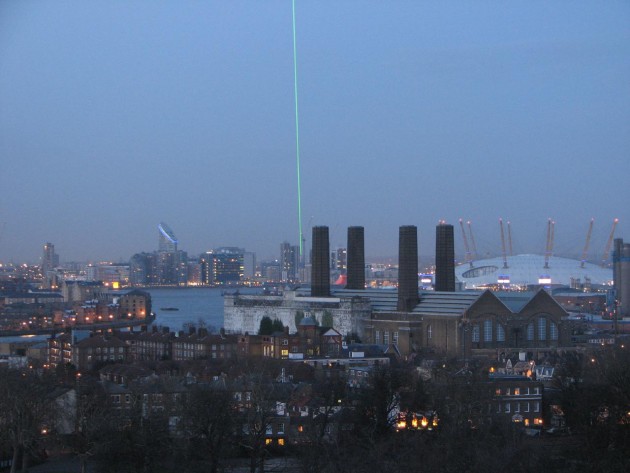
Greenwich Power Station photographed from the Meridian Line in the Observatory Courtyard in January 2008. The green line is a laser beam fired from the Observatory to mark its path northwards
What seems rather curious is that no one associated with the Observatory was formally consulted about the location. Nor was anyone consulted about the design and nor did they ask to be. Even more curious, is that despite the fact that the Power Station was being built right under his nose, William Christie, the Astronomer Royal, only started to raise objections in 1905 when phase one (of two) was nearing completion. In 1906, he shared his concerns with the Board of Visitors at the visitation which took place on 30 May.
By this time, phase one (the northern section) was largely up and running, having been officially opened just a few days earlier on Saturday 25 May. As was the norm, details of the visitation were reported in the press. In the ensuing weeks, numerous follow-up articles about the impact of the Power Station on the Observatory were published and questions asked in Parliament. In all the hullaballoo, the finger of blame when pointed, was largely directed towards the L.C.C. Very few asked why Christie, the Admiralty and the Board of Visitors were so slow in raising their objections ... and those who did ask, do not receive an answer.
A Parliamentary inquiry rapidly ensued. It made a number of recommendations in order to mitigate the impact of the Power Station on the Observatory. These included finishing the two chimneys of the yet to be completed phase two at a lower height than originally planned as well as taking steps to reduce vibrations.
Tramways in London
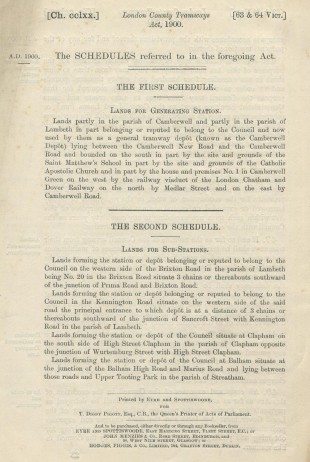
The schedules attached to the London County Tramways Act, 1900 describing the location at Camberwell where the generating station was to be built. The London County (Tramways and Improvements) Act, 1901, gave the council additional powers to enlarge the site by the compulsory acquisition of Saint Matthew's Girls' School which was located next door to it
The London County Tramways Act, 1900 gave the Council, powers to electrify certain tramways and to construct a generating station on the site of its tramway depot at Camberwell (but not elsewhere) to supply them. For various reasons, the Council later decided that their tram depot on the banks of the Thames at Greenwich, together with some adjacent properties (that they would need to acquire), would make a better site for the generating station. Amongst the advantages was that the river frontage would be convenient for the delivery of coal, the removal of ash and the supply of water for the condensers.
The London County Council (Tramways and Improvement) act, 1902, gave the Council the powers needed to build its power station at Greenwich. Much of the act dealt with the construction of new tramways and improvements to existing ones, with only a small section of its 34 pages being devoted to the Power Station. As well as giving the Council the powers to acquire the land required, the act stated that:
‘The Council may on the lands described in the said schedule erect maintain and use a station for generating and transforming electrical energy with all necessary engines dynamos plant and machinery.’
Prior to its completion, power for running the newly electrified section of line through Greenwich was obtained from the generating station operated by the London Electric Supply Corporation at Deptford (RGO7/66).
The tram depot at Greenwich (opened 13 December 1870) stood on land formally occupied by Crowley House and had been acquired by the L.C.C. when it took over the London Tramways Company at the start of 1899. They in turn had acquired it as part of the assets of the Pimlico Peckham & Greenwich Street Tramway Company which they took over in 1873.
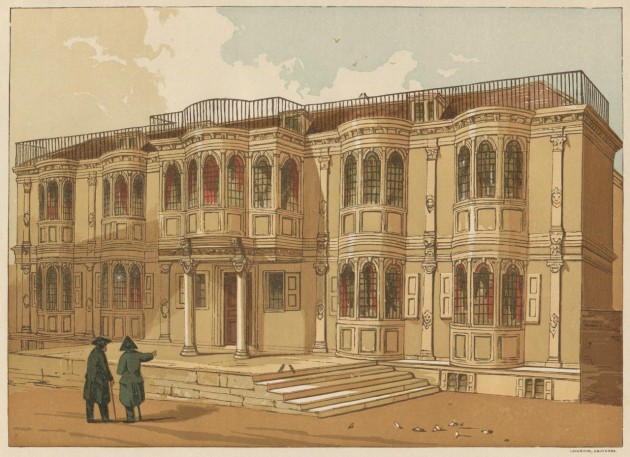
Crowley House from the banks of the Thames. Begun in 1647 the house was acquired in 1704 by Sir Ambrose Crowley, who added a warehouse to the east. This was demolished in 1853/4 followed by the house in May 1855. From 1870, part of the site was used as a tram depot and stables by the Pimlico Peckham & Greenwich Street Tramway Company. From Vol. 2 of Charles Knight�s Old England – A Pictorial Museum (James Sangster And Co. 1845)
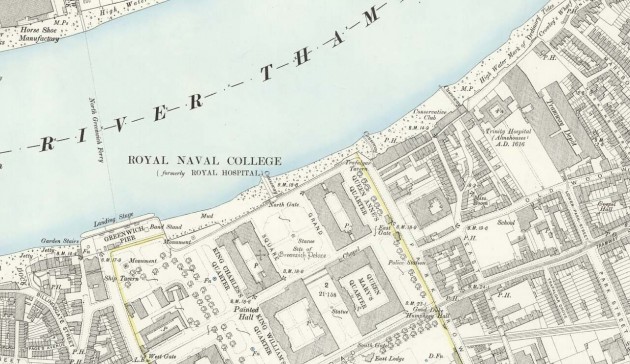
Map showing the location of the Greenwich Tramway Depot (top right). Detail from Ordnance Survey map ( 25 inches to one statute mile), edition of 1894�96. A total of 38 separate sets of premises were acquired by the Council in 1902. Of these, the house and public house (The Golden Anchor) by the river belonged to Colonel Alfred Margery and were leased to the City of London Brewery. The remainder were in Hoskins Street, Alfred Place and the Old Woolwich Road. They were owned by Merton College, but leased to just four individuals: Charles Robinson, Charles Smith, Frederick Fountain and Edgar Banks. 34 of the premises were recorded as being houses and in 1902 were occupied by 169 �persons of the Labouring Class�. Reproduced with the permission of the National Library of Scotland under the terms of the Creative Commons Attribution-NonCommercial-ShareAlike (CC-BY-NC-SA) licence (see below)
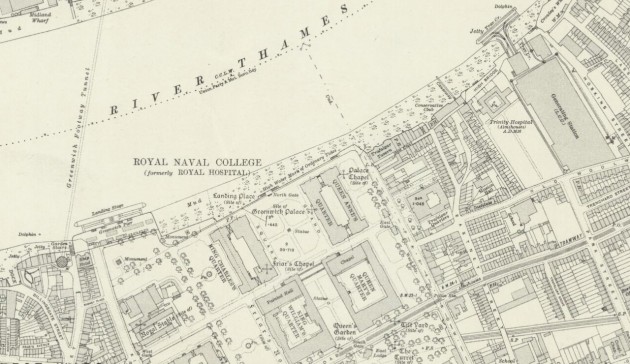
Map showing the location of the Greenwich Generating Station (top right). Detail from Ordnance Survey map ( 25 inches to one statute mile), edition of 1916. Reproduced with the permission of the National Library of Scotland under the terms of the Creative Commons Attribution-NonCommercial-ShareAlike (CC-BY-NC-SA) licence (see below)
Images of the Power Station under construction from Island Gardens
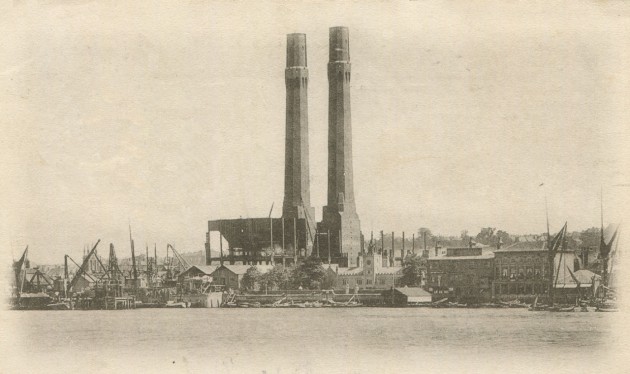
Phase one of Greenwich Power station in 1904. The two chimneys are complete and the construction of the steel frame of the rest of the building has just begun. From a postcard titled L.C.C. Electric Power Station, Greenwich published by Perkins son & Venimore
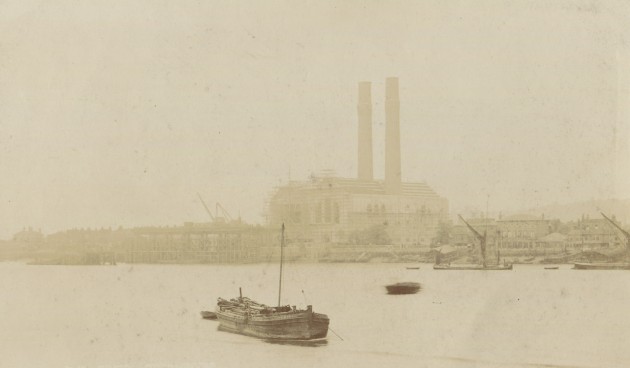
In this view which probably dates from 1905, the external structure of phase one is nearing completion. From a postcard published anonymously
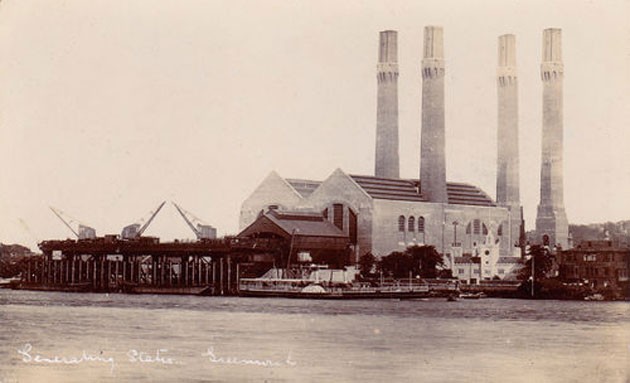
Perkins & Son, who published this image, superimposed a copy of the upper parts of the two left hand chimneys onto the two chimneys still under construction on the right. Why they did this is not known. The two chimneys were never, in fact, built to the height shown here. From a postcard by Perkins & Son c.1906
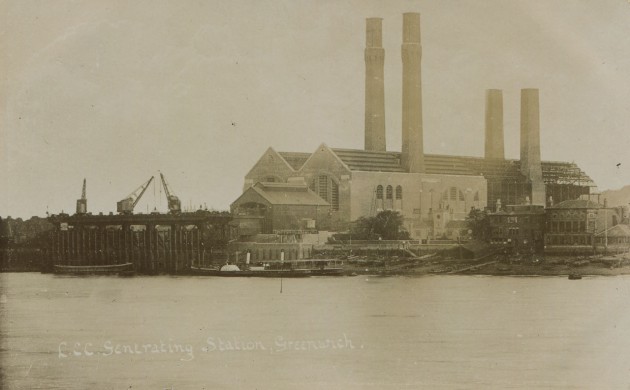
Probably dating from 1907 or 1908, the chimneys of phase two have been finished off at a lower height and the construction of the rest of the building is well under way. From a postcard by Perkins & Son
Images of the Power Station from the Observatory
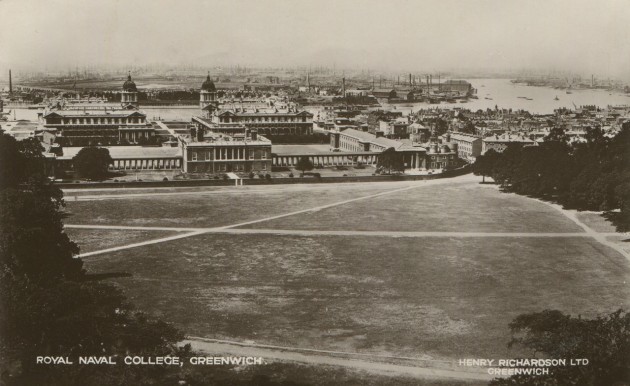
This view from the Observatory before the power station was built. Because there is no evidence of the tramway depot either, the photograph is thought to date from around 1870. From a postcard published by Henry Richardson
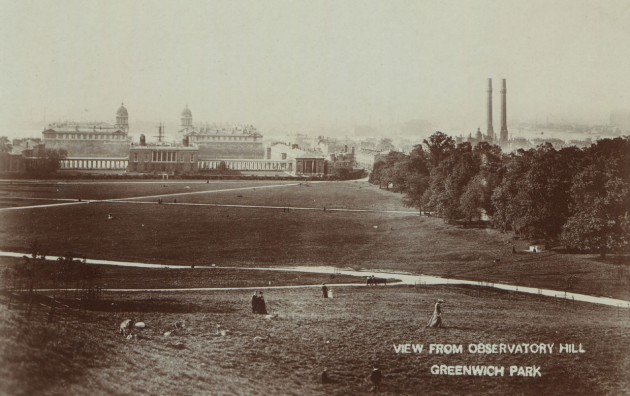
In this view from 1904, the two chimneys of phase one have been completed, but most of the rest has yet to be built. From a postcard published anonymously
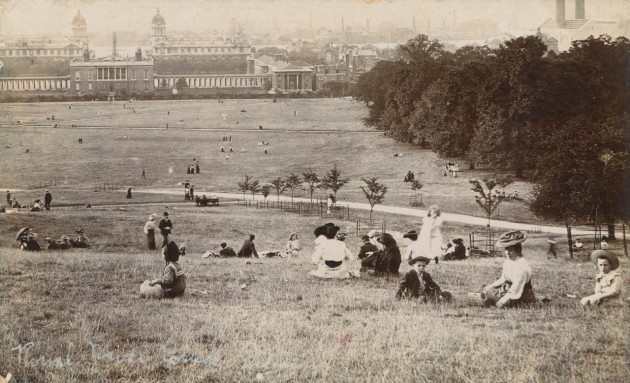
Probably taken in 1906, this view shows the recently completed phase one. From a postcard published by Perkins & Son
Images of the Observatory from the Power Station
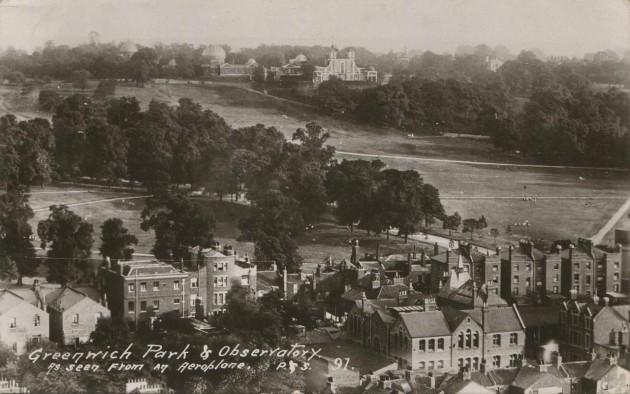
Thought to date from 1906, this photo shows the Observatory as seen from the top of the south west chimney of the Power Station. From a postcard by Perkins & Son, who published a number of different versions. At least five different titles are known to have been used: Greenwich Park; Birdseye view of Greenwich Park; Greenwich Park & Observatory; Greenwich Park, as seen from a Balloon and the title used on this version: Greenwich Park & Observatory, as seen from an Aeroplane. Postcards of the view in other directions were also published
November 1905 – the panic begins
Work on constructing the Power Station began almost immediately after the act of 1902 had been passed and by the end of 1903, the first two chimneys were nearly completed (RGO7/65). Although the height and position of the chimneys was one of the things Christie objected to, it was not until 2 November 1905, after another two years had passed, that he raised the matter for the first time with the Admiralty (RGO7/66).
What seems to have prompted his action was a report, about a visit to the Power Station by a group of Councillors from Paris, that appeared in 20 October edition of the Kentish Mercury. It seems that it was only at this point, that Christie realised, that what had been built so far, was only half of what was planned. What alarmed him further was an article in The Times on 30 October followed by another the following day that mentioned the Council’s proposal to seek Parliamentary powers to enable it to supply electrical power to a wider market. Although there was no mention of where this power would be generated, Christie presumed it would come from ‘a huge generating station at Greenwich’.
In his letter of 2 November to the Admiralty, Christie stressed that there was nothing in the 1902 act to indicate that the Power Station would be of ‘abnormal size’ with ‘exceptionally high chimneys’. He had, it seems, naively expected something similar to that of the rather smaller power station that had been built about on the river at Deptford around a mile to the north-west of the Observatory. Since its opening in 1889, (when it was London’s biggest power station), it had had, so Christie claimed, no discernable impact on the Observatory (more on this below). At about 150 feet in height, its chimneys were not only some 100 feet lower than those that had been built at Greenwich, but their tops were below the level of the Greenwich instruments.
Whilst the two completed chimneys of Greenwich Power Station were close to the Meridian of the Airy Transit Circle, they did not directly block the view along it. The issue here, was going to be one of turbulance in the atmosphere as a result of the hot gases coming from it once the Power Station came into use. The situation with the two that remained to be built was rather different as the most westerly of them would directly block the view of the Altazimuth when it was aligned to the north along its meridian.
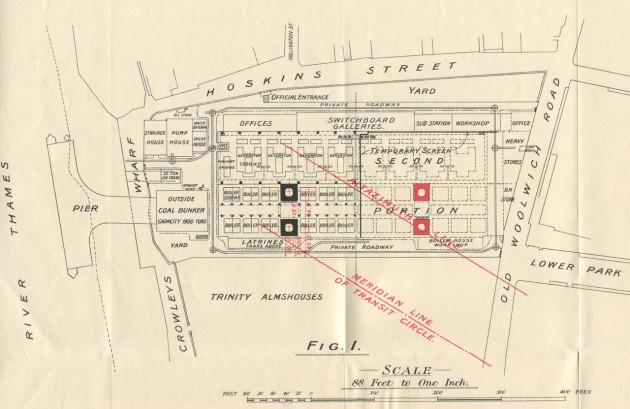
Plan of the Power Station showing the relative positions of the Meridian of the Transit Circle (the Prime Meridian) and the Meridian of the Altazimuth. The two black and the two red squares show the positions of the four chimneys. From the 1906 report of the Parliamentary Committee (see below)
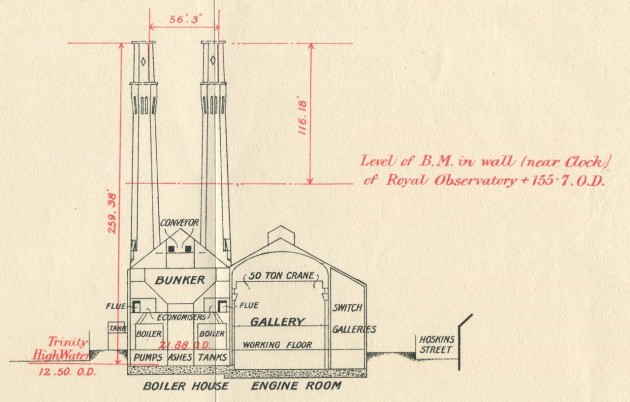
Sectional view showing the relative height above Trinity High Water of the top of the chimneys and the Observatory. Adapted from the 1906 report of the Parliamentary Committee (see below)
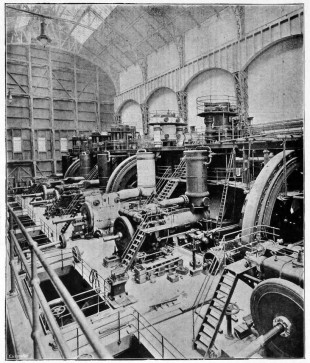
The Engine House in 1906. In this south facing view, several of the 3,500 Kilowatt Musgrave & Sons generators are visible, together with the large flywheels, which had a diameter of 27 feet. The wall at the far end was temporary and clad with corrugated iron. It was removed prior to the completion of phase two (which was built on its far side). The photo was reproduced in several contemporary publications. This version is from the 1 June 1906 edition of The Engineer and is reproduced courtesy of Grace's Guide under a Creative Commons Attribution-ShareAlike License (see below)
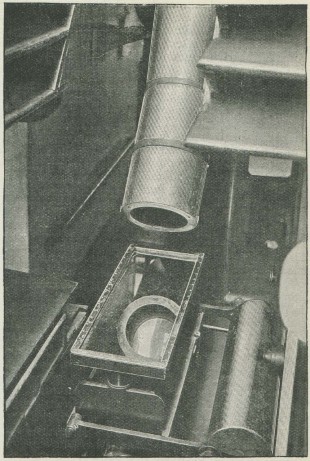
The mercury trough of the Airy Transit Circle. The mirror like surface was broken up by vibrations from the Power station. From The Leisure Hour, 1898 (London), p.563
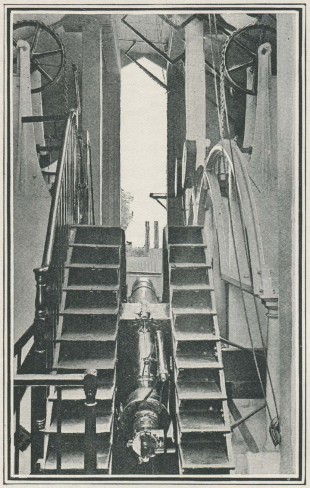
The north-west chimney of the Power Station is less than one chimney width from the Prime Meridian as defined by the Airy Transit Circle. From The Graphic, 23 June, 1906, p.809
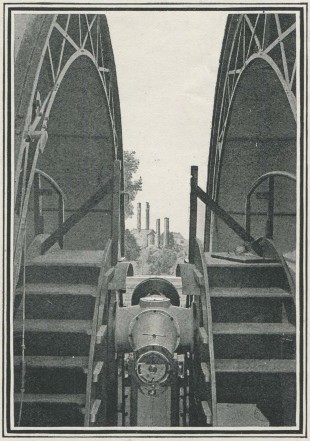
When the Altazimuth was aligned to the meridian, the south-west chimney blocked its view of the horizon. From The Graphic, 23 June, 1906, p.809
As soon as they became aware of the conflict of interests, the Admiralty set in train a series of meetings with the L.C.C. with a view to resolving the dispute in a way that satisfied all of the parties and hopefully avoided any litigation.
It soon became apparent that the height of the chimneys and the smoke they produced was only going to be part of the problem. Rather than use balanced turbine-gnerators, for phase one, the Council had chosen to install four less up to date vertical-horizontal steam reciprocating engine sets driving a flywheel-type alternator. These had the distinct disadvantage, from the observatory’s point of view, that they were unbalanced and would potentially cause problems with vibration. It was arranged that as soon as the first of them was up and running, a series of vibration tests would be conducted in cooperation with the L.C.C. engineers. One was run for the first time on 23 March 1906.
The vibrations from the engines caused tremors in the surface of the mercury used by the four instruments where observations were made by reflection the – Airy Transit Circle, the Altazimuth, the Reflex Zenith Tube and the small transit in the pavilion in the courtyard. This was particularly serious as if was from these observations that the level errors of the instruments were obtained.
On the 30 April, the first known mention of the problem appeared in the press in a general article about the nuisance of smoke from London’s growing number of power stations. This was published in The Daily News and carried a photograph of the new power station at Greenwich, the caption of which ended with the sentence: ‘It is contended that these works almost cut the meridian, and interfere with the work of the Observatory.’ As far as is known, this was neither followed up by The Daily News, nor was it picked up by any other newspaper.
Despite the fact that progress was being made in the talks with the L.C.C., Christie rightly felt compelled to inform the Board of Visitors about the situation. By then, the two chimneys of phase two had risen to a height of 180 feet. Christie concluded his 1906 Report to the Board of Visitors, (completed on 26 May), with the following statement:
‘The continued efficiency of the Observatory is seriously threatened by the schemes for the supply of electric power to the whole of London and surrounding districts from generating stations planted, or to be planted, in the immediate neighbourhood of the Observatory. Amongst these the most serious danger arises from the generating station of the London County Council, which is planted exactly in the Greenwich meridian, in a position where its excessively tall chimneys will, unless their height be materially reduced, interfere with observations of stars near the north horizon (which are essential for latitude and refraction) and will, through the effect of heated air, render the results untrustworthy. A reduction in the height of the chimneys (possibly accompanied by the introduction of forced draught) would provide an obvious remedy for this interference with the Greenwich meridian work.
Further, as this generating station is at a distance of only half a mile from the Observatory, there is grave risk that vibrations from the extremely powerful engines which are being installed there with a view to the supply of electric power wholesale to London, though authorised only for the requirements of the tramways [this was not strictly true], will seriously affect the value of observations by reflection from a mercury horizon, which are essential tor the fundamental work of the Observatory. Tests which have been made show that, even with the small portion of the engineering plant which is now available tor work, serious tremors are produced, and though it is hoped that these may be reduced by improved working of the engines, the alternative of providing a remedy for interference in this way with the Greenwich meridian work may have to be faced.
It is to be noted that no such tremors have been detected from a generating station at Deptford on a much more modest scale, which has hitherto sufficed to supply the London Council Tramways with electric power, this station being at a distance of nearly a mile from the Observatory.
The question arises why the immediate neighbourhood of the Observatory should be selected for the planting of generating stations on an unprecedented scale to supply electric power to distant districts. The very powerful engines required for such a large output are liable to cause vibrations, the extent of which could hardly be anticipated from previous experience of ordinary engineering plant or of railway trains, which have hitherto not affected the work of the Observatory.’
After it had been read to the Visitors at their meeting on 30 May, Christie went on to tell the Visitors that he had drawn the attention of the Admiralty to the problem ‘before the completion of the works’ and that they had been in communication with the L.C.C. with a view to preventing interference to the work of the Observatory. At the end of their discussion (unrecorded), the Visitors passed the following resolution:
‘That the interference arising from two sources, (a) vibration from the large electric installations half a mile to the north of the Observatory (b) heated air from the tall chimneys of the above installations, placed almost exactly in the meridian of the Greenwich Transit Circle telescope will have such effect on the observations as seriously to endanger the continued existence of the Greenwich Observatory as the reference point adopted by the whole world and particularly by mariners, and to destroy the continuity of series of astronomical labours undertaken for the benefit of mankind which have extended over 230 years.’ (ADM190/6)
Furore in the press
As was the norm, after the meeting, the Astronomer Royal’s report was circulated to the press. In the case of The Times, a brief report appeared the following day and a fuller one on 1 June. In the meantime, on 31 May, The Standard, The Tribune, The Daily Telegraph The Morning Leader, The Daily Graphic and The Westminster Gazette had all published much fuller stories about the threat to the Observatory. On that same day, H.H. Turner, a former Chief Assistant, Savilian Professor of Astronomy at Oxford and member of the Board of Visitors had penned a letter to The Times. This was published on 2 June.
Sir, – The Board of Visitors of the Royal Observatory at Greenwich found themselves confronted, at their annual meeting yesterday, by a grave anxiety. The London County Council have established in the Greenwich meridian and within half a mile of the Observatory a large station for generating electricity. There are already two chimneys 250ft. high, which rise from the river bed above the domes of the Observatory, in spite of the 150ft. of hill on which the latter is placed; as well as two other chimneys somewhat smaller, The disturbance caused by the hot air and smoke from all these chimneys cannot fail to be serious, though it is at present impossible to estimate it quantitatively. But there is another source of disturbance of an alarming kind of which direct evidence has already been obtained. In spite or various precautions taken, the engines of the generating station are so powerful that they shake the Observatory. The delicate observations for nadir, which furnish the reference points for Greenwich time and for terrestrial longitudes, indicate a state of constant vibration while the engines are running, which will, be greatly increased if the full proposals of the London County Council are carried out. By the invitation of' the Astronomer Royal I paid a special visit to Greenwich on Tuesday and was able to compare for myself the state of matters during the running of the engines and after they had been stopped, (i.e. after midnight). The Observations left no room for doubt as to the seriousness of the disturbance.
In one important respect the Board of Visitors had reason to be well-satisfied. They learnt from the Astronomer Royal and from the Hydrographer to the Admiralty [a member of the Board] that the Admiralty are deeply concerned about the threatened danger, and are using their influence to minimize it. The duty of the board, therefore, which is to report to the Admiralty, resolved itself in this instance into a simple expression of their hearty concurrence with the steps already taken, and an earnest hope that they might be successful. But it is clear that matters of grave public importance are at stake, and I hope there is no impropriety in my addressing to you, unofficially, but as a person having knowledge of the facts, some remarks on two points on which it seems probable that the public will desire some information.
The first point might be formulated as a natural question: – How has it happened that a scheme threatening such danger to the Observatory has advanced so far towards realization? This is a question which must be frankly faced some time or other; for there is no blinking the fact that there is a conflict of interests on a very large scale, and a serious sacrifice will have to be made on one side or the other. But it is impossible to consider this question adequately here. I do, however, wish to ask whether another question should not precede it – namely, what should be the attitude of the London County Council towards the existing institutions of London?
...
In response, an unnamed member of the London County Council (Fitzroy Hemphill?) wrote to The Times the next day to defend the Council’s actions. His letter, which was published on 7 June, ended as follows:
‘But now may I, in turn, ask a question – viz., What was the Astronomer Royal about that he raised no objection to the building of the generating station until the County Council had spent or was committed to the spending of, at least five or six hundred thousand pounds? Such an enterprise is not conceived in secrecy. An act of Parliament is needed for its initiation. The newspapers report the proceedings of the Committees of both Houses which enquire into Bills. They report also the more important proceedings of the meetings of the County Council. The Astronomer Royal should, therefore have known what was intended and about to happen. He may not have known until they were completed the height to which the chimneys would rise, but he must have known, if he troubled to think, that the buildings he saw in progress were chimneys rising out of huge boiler and engine houses. For what purpose, unless for the installation of powerful machinery, did he think they were being erected? He cannot evade the responsibility which rests upon him or shelter himself behind a brother scientist’s complaint against the London County Council’
To this, there was no reply.
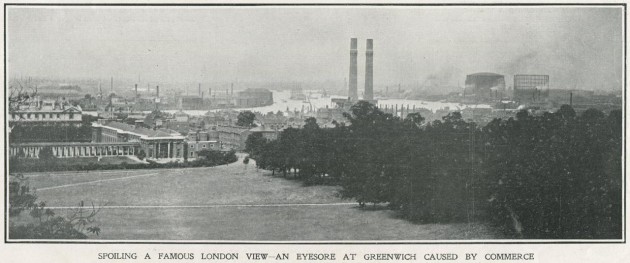
As well as berating the L.C.C for the potential impact of the Power Station on the Observatory, much of the press also regarded it as an eyesore. The Sphere joined the bandwagon when, on 2 June 1906, it published this image which had been taken two years earlier. The accompanying paragraph began: 'The beautiful and historic stretch of the river at Greenwich, hitherto imperilled by ghastly gasometers, has finally been destroyed by the appearance of two chimneys erected by the County Council for their new electric generating station, opened last Saturday.'
Questions in the House
On 21 June, the matter was raised in the House of Lords. During the debate that followed, the Earl of Crawford revealed a previously unknown fact:
‘Reference has been made by the noble Viscount [Goschen] who has just sat down to the mistakes committed by many and various public Departments [including the Astronomer Royal], but I think there is one mistake which has not been alluded to, but which ought to be noticed in this connection, and that is that the architect to the London County Council had been employed at the Royal Observatory at Greenwich. He was employed to put up the buildings for the important instrument to which the noble Lord the First Lord of the Admiralty referred. The chimney is absolutely on the meridian of that instrument. That ought not to have been allowed. The chimney might easily have been placed in a different position, and I think the architect, knowing the importance of the instrument erected in the Observatory, ought to have noticed this defect.’
The architect referred to was William Riley who in 1877 had joined the staff of the Director of Engineering and Works of the Admiralty, and rose to the rank of Assistant Director. In 1899 he had been appointed as ‘Superintending Architect of Metropolitan Buildings and Architect to the London County Council’.
Whilst it was true that Riley had had input into the recently constructed New Physical Building and Altazimuth Pavilion at the Observatory, he had had no input into the selection of the site for the Power Station. Once this had been pointed out to Crawford, a graceful apology was issued via a letter to The Times (which had earlier reported on the debate).
As well as being reported in Hansard (as was the norm), the debate was also reported in the July 1906 edition of The Observatory. This, it is worth noting, was the magazine that had been founded by Christie and whose editors Thomas Lewis and Henry Hollis were both Assistants at the Royal Observatory, Greenwich. As such, its impartiality on the matter has to be questioned.
The Parliamentary Inquiry
Within weeks of the meeting of the Board of Visitors, a Parliamentary Committee had been put together. It had just three members: The Earl of Rosse (representing the Royal Observatory), Sir Benjamin Baker (representing the London County Council) and James Alfred Ewing (representing the Admiralty).
The 4th Earl of Rosse, Lawrence Parsons, was an astronomer and one of the Observatory’s visitors who had served on the Board since 1886. Baker was a civil engineer and Chief Engineer of the Council and probably best known today as the designer of the Forth Bridge. Ewing was a physicist and engineer who in 1903 had been appointed by the Board of the Admiralty as Director of Naval Education at the Royal Naval College Greenwich, having previously been Professor of Mechanism and Applied Mechanics at the University of Cambridge.The terms of reference were as follows:
1. To inquire into the working of the engines now in position at the London County Council Station, and the amount of vibration caused by them, and what detrimental effect they have, if any, on the instruments in the Royal Observatory, and whether such disturbance, if found to exist, is caused by the station engines alone, or arises in whole or in part from other causes.
2. To inquire into the anticipated amount of vibration, and consequent detriment to the Observatory which may be caused when the station is in full working order.
3. To inquire into and ascertain the mode in which such vibration is produced and is conveyed to and affects the instruments used in the Royal Observatory, and to consider how, and by what methods, steps can be taken for preventing or neutralising it, either at the source or elsewhere, by alteration in the machinery used at the station or otherwise.
4. To consider how far any smoke or heated air from the chimneys belonging to the generating station, or the physical obstruction of the chimneys themselves, may be expected to interfere with observations from the Observatory, and to consider by what means this interference can be abolished or modified.
The committee reported at the end of the year. In all, they made six recommendations which they summed up as follows:
(a) The question, both as regards effects of vibration and obstruction through chimneys or discharge from chimneys, to be further reviewed after, say, two years, by which time experience should be obtained with the second portion of the station at work.
(b) The generating plant for the second portion to be turbines which, as well as the dynamos, must be of a perfectly balanced type such as has been proved by trial not to cause vibration.
(c) An undertaking to be obtained that when the plant in the second portion is available for use, the reciprocating engines of the first portion shall not, in ordinary circumstances, be used after 10 p.m. and their use shall be restricted as far as possible after 8.30 p.m.
(d) The two chimneys of the second portion, at present incomplete, to be not higher than 204 feet above Ordnance datum.
(e) The discharge of gases both from these and from the existing chimneys not to be materially hotter than the discharge is now from the existing chimneys, namely, about 250º Fahr.
(f) No further extension of the station to be made beyond the 20,000 kilowatts now contemplated in the equipment of the second portion.
The recommendations were subsequently accepted by both the Admiralty and the L.C.C., with the later finally agreeing to them in October 1907 (RGO7/66).
A solution to the problems of vibration
Fortunately for all concerned, experiments conducted on the design of the mercury troughs showed that the tremors in the surface of the mercury could be eliminated by altering the profile of the bottom surface and the depth of the mercury they contained. More details on this can be found in the Committee’s report (link above).
Completion of phase two
Built from London stocks, with Portland stone cills, copings, and dressings and a roof covered with Bangor slate, the completed Power Station had a total volume of 9,670,000 cubic feet. An early example of a steel framed building in Britain, it is today generally admired by architectural historians. The tapered octagonal chimneys as designed had crisply corbelled and machiolated tops. The decision not to complete the southern pair to their full height had a hugely disfiguring effect on the building’s overall appearance. Phase two is believed to have been completed in about 1910, about a year after the two photographs of the turbine hall below were taken. The total cost as estimated in 1906 was £900,000.
With regards to the turbines used in phase two; although the Committee recommended the use of balanced turbines, the decision to use such plant in phase two had in fact already been made before phase one was officially opened.
Although today the question of air quality is high on the political agenda, this was not the case when the Power Station was built. No thought at all seems to have been given to the potential increase in air pollution that was likely to occur by failing to build the southern chimneys to their originally intended height.
A failure of corporate memory?
As long ago as 1835, while the London and Greenwich Railway was still under construction, proposals had been under discussion for a line that would cross Greenwich Park on a viaduct between the Queens House and the Observatory. The proposals were considered by the Astronomer Royal (John Pond) and the Board of Visitors, both of whom raised their objections on the grounds that vibrations from the trains would almost certainly interfere with the observations by reflection that were made with the two Mural Circles. So concerned were the Visitors that they asked one of their number, Captain Beaufort, to investigate the matter further. A series of tests were therefore carried out on his behalf alongside the Liverpool & Manchester Railroad. The results suggested that vibrations from trains running across Greenwich Park would almost certainly affect the Observatory.
On the 25 January of the following year, George Airy, the new Astronomer Royal, conducted further tests in the Glebe Meadow near the Surrey Canal and about 200 feet south of the London and Greenwich Railway, which by then was carrying test trains prior to its partial opening in February. They too suggested that there would be an impact, but that it could be mitigated by ensuring a minimum distance was maintained between the Observatory and the railway and that the trains be restricted in both their speed and their times of passage. The proposals continued to be pushed forward in various forms for the next 30 or so years and involved various further tests including a series that Airy undertook at Kensal Green in 1846. In the meantime, a line was built around the Park connecting the North Kent coast to London via a tunnel that ran from Charlton to Blackheath. This line, opened in 1849.
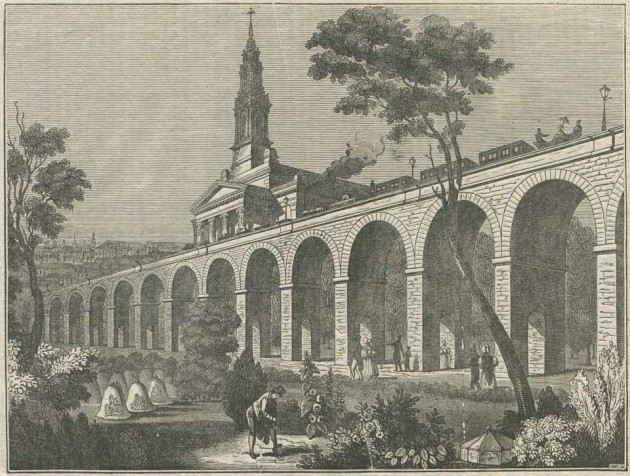
The London and Greenwich Railway, near Bermondsey New Church (Vasey Sc.). The railway was (and still is) carried on a viaduct all the way from London Bridge to Deptford. The Surrey Canal passed under the viaduct about 350 metres to the east of the present waste incinerator. From the 9 January 1836 edition of The Penny Magazine
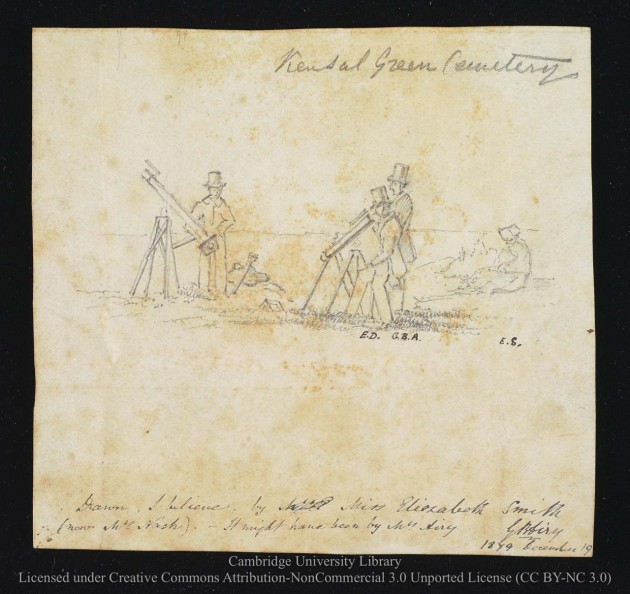
Airy and his party at work at Kensal Green in 1846. Two telescopes were placed on opposite sides of a small tray of mercury (which was protected from the wind by a glass roof) and directed towards the mercury in such a way that the wires in the focus of one telescope could be seen distinctly by reflection with the other telescope. In the drawing, the observer Edwin Dunkin (E.D.) is standing next to Airy (G.B.A.). Pencil drawing by Elizabeth Smith or Ricarda Airy, 28 February or 9 March 1846. Reproduced under the terms of a Creative Commons Attribution-Non-Commercial 3.0 Unported License (CC BY-NC 3.0) courtesy of Cambridge Digital Library (see below)
In 1863, in response to yet another proposal to tunnel under the Park, Airy conducted further tests in two new locations, the two sites having similarities in soil structure with that of the Observatory. They were near the entrance to the existing Charlton to Blackheath tunnel by Morden College in Blackheath and near the Metropolitan Railway at the upper end of Portland Place near The Regents Park. From these experiments Airy concluded that any new tunnel should not pass closer to the Observatory than 1,000 feet. In the end, plans for a tunnel across the Park were abandoned and the line from Greenwich extended instead via a tunnel that passed under the grounds of the Royal Hospital School (now the National Maritime Museum). This eventually opened in 1878 and passed at a minimum distance of 570 yards from the Transit Circle.
Further tests were carried out in 1888, when amendments to the 1887 Bexley Heath Railway Act were being discussed in parliament as a result of a proposal to build a new tunnel under Blackheath that would pass within 840 yards of the Observatory. This time, tests were carried out by Christie at the Observatory itself, using the Airy Transit Circle (RGO7/59). Worryingly, it was found not only ‘that the disturbance was very great during the passage of trains between Greenwich and Maze Hill’, but that ‘there was considerable disturbance during the passage of trains through the Blackheath-Charlton tunnel, at a distance of a mile.’ As a result, firstly, the construction of the tunnel was not allowed and secondly modifications were made by Christie to the mercury troughs of the telescopes to damp out the vibrations.
Trains however weren’t the only source of troublesome vibrations. Back in 1851, Airy had had to contend with the problems of vibrations with his newly installed Reflex Zenith Tube. Installed in small room next to the new Transit Circle, every time the adjacent courtyard gates were opened or shut, a jarring of the mercury would result. In 1853/4, Airy decided that a new room for the telescope should be constructed on the other side of the Transit Circle roughly 12 metres further from the gates. Here too there were problems, with the mercury suffering from an intolerably large and never ceasing tremor. It was eventually realised that the vibration problem was a result of the very structure of the hill itself, its compacted mix of sand and pebbles leading to the ready transmission of vibrations and tremors. The problem was eventually mitigated by backfilling the pit in which the mercury trough had stood with ‘incoherent rubbish’ and then suspending the mercury trough on a complex arrangement of staging. Interestingly, the problem of transmitted vibrations does not appear to have affected the mercury troughs that had been used with the Mural Circles since 1822, nor the Transit Circle that replaced them.
Given the long history of both dealing with vibrations and seeing off schemes that would directly impact the work of the Observatory, one has to ask, when it came to the question of Greenwich Power Station, was it a question of complacency on the part of the astronomers or was it a failure of corporate memory that caused the failure to respond?
A dereliction of duty? – the fitness for purpose of the Board of Visitors
Christie was not alone in failing to make the connection between the evolving Power Station and its potential impact on the Observatory. What questions if any were asked by the two Chief Assistants, Frank Dyson and Philip Cowell? The Board of Visitors, who always held their annual meeting at the Observatory, were most certainly asleep on the job.
At their meeting in June 1903, they too would have seen the chimneys under construction. By the time of their 1904 meeting, the chimneys would have been completed and by the time of the 1905 meeting, the whole of the external works of phase one would have been coming to an end. Even if they had failed to notice the Power Station’s looming presence on their way to and from the Observatory, they can hardly have failed to notice it from the vantage point of the Octagon Room where their meetings were held. Regrettably, the minutes of the meetings of the Board are, as a matter of course, somewhat rudimentary. As such, they shed no light on what may or may not have been discussed on either a formal or an informal basis.
It is apparent from Turner’s letter to The Times (above) that the function of the Board as he (and presumably they) saw it, was largely to act as a sounding board for the Astronomer Royal and then to pass any appropriate resolutions. It does not seem to have occurred to him that the Board itself could (and should) have taken action an awful lot earlier.
The terms of reference of the Parliamentary inquiry were entirely about finding a resolution to the problems of the Observatory and the L.C.C. The Board of Visitors was never held to account and it was arguably to the long term detriment of the Observatory, that there was not a parallel inquiry into their role and the way in which they were constituted to see if they were still fit for purpose. It is hard to believe that a board with such a narrow range of interests would be allowed to exist today.
Stress & illness – a possible explanation for Christie’s slowness to react?
By the start of the twentieth century, Christie’s building programme at Greenwich had come to an end. With the new telescopes and facilities, came a significant increase in both the range and amount of work being done. With high staff turnover amongst the temporary computers, Christie came under considerable personal pressure which inevitably took its toll.
Shortly before the meeting of the Board in 1905, Christie was ordered by his doctor to give up his work immediately, leave Greenwich, live in the open air and give up his duties and responsibilities altogether (ADM190/16). The physician’s report sent to the Board’s Chairman, Sir William Huggins, stated amongst other things that his capacity for work was small and for sustained work was nil. His reported symptoms suggest he was suffering from a combination of stress and heart failure. As a result, he missed the annual meeting of the Board.
According to Dyson, the illness was a repeat of one that he had had a few years earlier. Reading between the lines, it seems likely that Christie was afflicted throughout his last ten years as Astronomer Royal. Records are scanty, but we do know that the 1910 visitation was postponed by two weeks because of his illness (ADM190/16). We also know from what Turner wrote in his obituary, that Christie lacked energy in his later years. This would have affected his ability to lead effectively and was almost certainly something of which the Visitors were aware, even though it is never formally alluded to in their records.
The weakness of some of Christie’s scientific arguments
Some of Christie’s arguments do not necessarily stand up to scrutiny. As Astronomer Royal his authority was effectively deemed not open to question. Below are some of the areas where he might have been probed or challenged more deeply. Having said all that, the only recommendation of the Parliamentary Committee that might have been different is that the two southerly chimneys might not have been a problem had they been built to full height. However, given the economics of completing them to the full height and then lowering them again after two years if they were indeed a problem, the solution adopted to finish them at 182 feet was certainly the pragmatic one.
Existing obstructions on the Meridian of the Airy Transit Circle
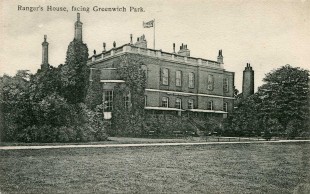
The Ranger's House in the early 1900s. The Meridian of the Airy Transit Circle cuts through the higher part of the building to the left of the flag. Postcard published anonymously
Vibrations from Deptford Power Station
Deptford Power Station supplied its first electricity in November 1889. A few weeks earlier however, on 26 September, the mercury trough of the Airy Transit Circle had been furnished with a bottom of amalgamated copper in an attempt to damp out the disturbing effects of tremors attributed to passing railway trains and road traffic (RGO7/29). A similar change to the trough of the Reflex Zenith Tube had previously been made on 13 February 1889 (RGO7/29). The change to the Transit Circle produced very beneficial results as regards steadiness of the images and as a result, the trough was replaced by one of amalgamated copper the following year. The modified design may also have had an effect on any vibrations arising from Deptford. Christie’s claim therefore that the Power Station had run with no discernable effect on the Observatory whilst being true, was potentially misleading.
Purpose of the Altazimuth
Christie’s Altazimuth was erected in 1896. Essentially a reversible transit circle, it could be set up to point not only along the meridian, but at different predetermined angles (azimuths) to it. Its main purpose was to make extra-meridian observations of the Moon, especially around the time of New Moon when it was close to the Sun and impossible to observe as it crossed the meridian. When used in this mode, the presence of the Power Station chimney would have been an irrelevance. Questions about the mode of use of the Altazimuth were never asked. Nor were questions about its effectiveness or reliability.
The truth about the inviolability of the Airy Transit Circle
The supposed importance of the 1884 International Meridian Conference and the so-called international obligations was somewhat over-egged.
In 1906, the Airy Transit Circle was in its 56th year of operation. An identical instrument installed at the Cape Observatory in 1855 had just been replaced with one of more modern design. Although there were no immediate plans to replace the Greenwich Instrument, it would inevitably have needed to be replaced at some point. The physical nature of the Greenwich site (and historic precedent) would mean that any new instrument at Greenwich was unlikely to be placed on the same meridian as the old. As it turns out, the Airy Transit Circle ceased to be used to determine the clock errors in 1927 when it was decided to use the small reversible transit instrument in the nearby Transit Pavilion to the west instead. As a result, a small offset to the determined time was applied to bring it into line with the time on the Greenwich Meridian. The other functions of the Airy Transit continued as before until eventually being taken over by the Cooke Reversible Transit Circle, a new telescope that was ordered in 1931 and originally set up in the Christie enclosure some 400 yards to the east of the Greenwich Meridian before being moved to Herstmonceux after the war.
It is worth noting too that the determinations of the difference in longitude between the observatories of Greenwich and Paris that were made in 1888, 1892 and 1902 while Christie was Astronomer Royal, were made from two observing stations on different meridians in the Observatory Courtyard and an offset applied to allow for their distance from the Greenwich Meridian.
Later, in 1912 when the Royal Society was consulted about plans to increase the power output from the Power Station, it received a letter from one of its fellows suggesting that the Observatory might be moved to a potential site ten miles to its immediate south. In response, Dyson gave a more honest assessment of the position, writing ‘… it does not seem to me that any weight attaches to the fact that the suggested site is on the Greenwich Meridian, If the Observatory had to be moved, it would be as regards time and zero of longitude, comparatively an easy matter to make allowance for the difference between the new and old positions, but the conditions at present are not such as would justify the great expense and difficulty of moving the Observatory …’ (RGO7/66)
The legal protection of observatories
Back in December 1890, small uncountable agitations had begun to be detected in the Horizontal and Vertical Force traces in the Magnetic Observatory at Greenwich. These corresponded to similar disturbances detected by the Earth Current registers. They started around 7 o’clock in the morning, ended around 11 o’clock at night, and were generally absent on Sundays. The following summer it was eventually realised that they were caused by the City and South London Railway (now part of the Northern Line) which ran from Stockwell to the City of London. Four years in the making, the railway was the first electric railway in London. Officially opened by the Prince of Wales on 4 November 1890, it opened to the public on 18 December. It operated at 500V DC using an insulated third rail to deliver the current, with the return being via the uninsulated running rails.
Had the power delivery system been such that all the return current flowed along the rails back to the substation, the magnetic fields produced by the outward and return currents would have more or less cancelled each other out, limiting the disturbed area to the vicinity of the railway. However, the return rail was not insulated from the ground, and part of the return current leaked into the earth. Not only did this reduce the cancellation effect (thereby affecting the Observatory), but the leakage currents created their own, smaller, magnetic fields as well.
Although, at this distance, the interference with the magnetic registers was not considered severe, it was only a matter of time before proposals would be made to electrify the multiplicity of existing lines and tramways in London. The closer they ran to the Observatory, the greater the impact they were likely to have on the magnetic instruments and the value of the magnetic records.
By 1893, a clause had been agreed for insertion in future parliamentary railway or tramway bills authorising electrical power, in order to protect not only the Greenwich Observatory, but also the magnetic observatory at Kew (established in 1857) along with various other government scientific establishments in London. Amongst its provisions was the stipulation that ‘either insulated returns or uninsulated metallic returns of low resistance’ should be used. The clause was inserted in numerous bills, which in the case of Greenwich included any that related to a line that came within originally ten, but later five miles of the Observatory.
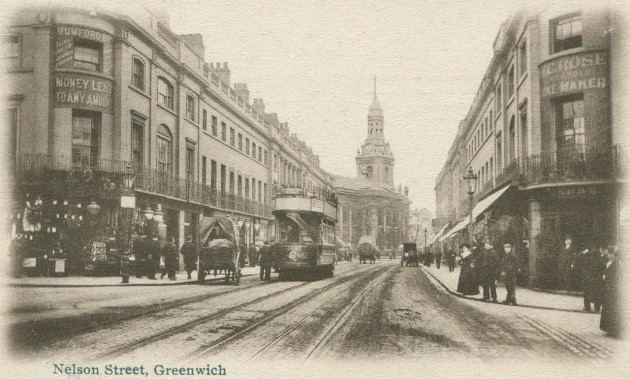
A tram in the centre of Greenwich in about 1904, shortly after the track had been electrified. The line ran less than half a mile from the Observatory. From postcard 651 published by Perkins, Son and Venimore (PS&V)
Although the 1902 Act did not in itself provide the Observatory with any protection, had the dispute with the L.C.C. gone to litigation, Christie suggested that this clause, which had been included in other acts and was designed to protect the observatory from the use and leakage of electrictity, could be invoked on the grounds that test experiments had showed that when the electricity from the Power Station was used with a constant load the vibration was smaller than when it was with the variable load of the tramways. Since it was the use of electricity for the tramways that caused the excessive vibration, the generation of the electricity could not, so Christie argued, be dissociated from it. (RGO7/66).
A brief history of the Power Station from 1910 until today
One consequence of agreeing to abide by the recommendations of the Parliamentary Committee was that the L.C.C. found its hands tied when it wanted to upgrade the four 3,500 KW reciprocating engines of phase one with four turbines with more than double the output. They also wanted to raise the shorter chimneys by 60 feet. As a result, a new dialogue with the Admiralty was commenced in 1911. In early 1913 the Admiralty agreed to the turbines being substituted for the existing reciprocating engines subject to following three conditions that had previously agreed in 1907 being retained:
1) that the height of the chimneys would not be increased
2) that the temperature of the gases did not exceed 250º Fahrenheit
3) that no further development of the station would take place.
Although agreement was reached in 1913, it took until 1922 for the last of the reciprocating engines to be replaced. A few years later, in around 1927, a run of reinforced concrete high level reserve coal bunkers were built on the west side of the boiler house. Regrettably, as with the lowering of the southern chimneys, the architectural integrity of the original design was severely compromised in the process. Originally painted white, the bunkers still survive but have been black in colour since remedial work was carried out on them in 2013.
In 1930, a programme of modernisation began that involved the replacement of the turbine generators with new turbo-alternators of higher output. When the London Passenger Transport Board (London Transport) was formed in 1933, control of the power station passed to it from the L.C.C. Over the following years further upgrades took place in part to meet the change in demand for electricity.
Between 1969 and 1972, the power station underwent a complete modernisation programme, with the coal-fired boilers and generators being replaced by eight gas turbine alternators fired by oil and the two northern chimneys being reduced to the same height as the others. From that time onwards, the power station served as a backup to London Transport’s Lots Road Generating Station at Chelsea which had originally been opened in 1905 to serve part of the underground network. In 1998 London Underground shut Lots Road and switched to the National Grid for its power supplies. At this point, the role of Greenwich changed, with the station becoming the provider of emergency power to the London Underground.
In 2015, the then Mayor of London, Boris Johnson, announced plans to install six new gas engines and introduce a district heating scheme for nearby homes and buildings. Although the scheme did not require planning permission, it did require approval by the Environment Agency to whom the proposal was submitted. Following local objections that the scheme would increase air pollution by adding to the already high levels of Nitrogen oxide, the proposal was withdrawn at the end of 2016 ‘to allow time for a review of the project to ensure it aligns with the priorities of the new Mayoral administration’.
Airbrushed from history?
Although the problems caused by the siting of the Power Station on the Greenwich Meridian were well reported in 1906, they are scarcely mentioned in later accounts and histories. One recent paper (described elsewhere as ‘seminal’) makes no mention at all of the Greenwich Meridian and has only the briefest of mentions of the Observatory. Likewise the considerably shorter article in Wikipedia (accessed March 2017). That this should be so is probably due to an over-reliance on the accounts that were published in connection with the opening of phase one in 1906. These all pre-date the very public debate that followed soon after.
Further reading & viewing
The London County Council Tramway Power Station at Greenwich. Engineering, 2 March, 16 March & 30 March 1906
The Greenwich electricity supply station. The Engineer, 1 June 1906, pp.560–62
Coal and ash handling plant – Greenwich Power Station. The Engineer, 17 August 1906, p.177
The Times, 31 May; 1, 2, 4, 7, 14, 21, 22 & 27 June, 4 & 6 July, and 8 August 1906
Modernisation of Greenwich Generating Station. London Transport 1971 (8 pages text, 7 photographs & one plan)
The development of the electrical supply industry in north-west Kent 1882-1914. B.J. O’Neill. The Local Historian Vol.30 No.1 (Feb 2000) pp.23-38 (downloads as pdf)
Greenwich Generating Station. Peter Guillery. London’s Industrial Archaeology Number 7 (2000)
Low Carbon Plans. BBC News, 8 Jan 2015 (video clip showing interior of Greenwich Power Station)
Archives
TfL Research Guide No.30, Lots Road and Greenwich Power Statons (pdf)
Royal Greenwich Observatory RGO7/65, RGO7/66
Image licensing
The detail from the two Ordnance Survey maps is reproduced with the permission of the National Library of Scotland under the terms of the Creative Commons Attribution-NonCommercial-ShareAlike (CC-BY-NC-SA) licence
The 1906 image of the Engine House from The Engineer is reproduced coutesey of Grace’s Guide under a Creative Commons Attribution-ShareAlike License
The image reproduced courtesy of Cambridge Digital Library has been reduced in size and is more compressed than the original and has been reproduced under the terms of a Creative Commons Attribution-NonCommercial 3.0 Unported License.
© 2014 – 2025 Graham Dolan
Except where indicated, all text and images are the copyright of Graham Dolan
